Without any disrespect to the Nepalese team, if the Socceroos were playing a far superior team, could they have possibly won the game, with their current squad, let alone in such dominating fashion?
The Socceroos smashed Nepal 5-0 at the Asian World Cup Qualifier in Canberra yesterday. Australia was the far superior side, as one would have expected, they rank 44th in the world, whereas Nepal is placed at a measly 161 ranking. Jaimie Maclaren scored a fine hattrick, and the tall centre-back, Harry Souttar scored two great goals on debut.
I have to give it to the Gorkhali fans in the stadium though, I was in attendance, and they did not stop celebrating for a second, running around the stadium and chanting in Nepalese.
However, without any disrespect to the Nepalese team, if the Socceroos were playing a far superior team, could they have possibly won the game, with their current squad, let alone in such dominating fashion?
Despite often being referred to as an “Asian Powerhouse”, this is not the Socceroos squad of yesteryear, it does not possess a single superstar or player that can change a game.
Neither is it the sort of team that gels together, like various parts of a well-oiled machine. Has Australian football (soccer) lost its flair?
In another day and age, the Socceroos were a force to be reckoned with.
They beat Uruguay to qualify for the 2006 World Cup. They qualified for the knockout stages, placing second in a group that consisted of Brazil, Croatia and Japan!
READ: The Melbourne Cup - Sports’ Ugly side
Every Aussie can remember the days of their golden generation, you only have to mention their loss at that tournament to Italy, for people to remember what could have been.
This was the very game where Australia dominated possession, the mischievous Materazzi was sent off, and it looked like Australia might push through, until that cursed penalty.
Considering the Italians won that tournament, perhaps, it was not the worst way to go.
That squad was without a doubt the finest of any generation of Australian footballers.
With players like Harry Kewell, Mark Viduka, Mark Schwarzer, Lucas Neill, Tim Cahill, and others like Tony Popovic, Brett Emerton and Craig Moore, these players meant something to the world.

Let’s take a look at what some of these players meant to Australia and the world.
Australia’s greatest ever footballer, Harry Kewell, spearheaded the line-up, known for his ability to play across the front of the attack. A man who was adored at country and clubs alike.
Be it Leeds, Galatasary or Liverpool – Where the scousers would affectionately sing ‘Harry, Harry, Harry the red Kangaroo, Harry, Harry, Harry a red through and through.’
Then there was Mark Viduka, captain of that famous 2006 World Cup team.
The man scored over 200 club goals across the 6 clubs that he represented in his 16-year career.
An immigrant from Croatia (also the cousin of Luca Modric), Viduka was the kind of man who commanded respect, and his ability to score goals was majestic.
Then, of course, there was Mark Schwarzer, at 6”4 inches, he remains the most capped player for the Socceroos.
From a German background, it was no surprise the man chose football as his sport of preference. He was a formidable force between the two posts for Middlesborough in the English Premier League, and arguably, the finest keeper from this part of the world during his prime.
How can we forget Lucas Neill, Australia’s most-capped captain, who plied his trade in England, playing for clubs like Everton, Millwall, Blackburn and West Ham United, before moving to Galatasary, like his peer, Harry Kewell.
His mate, the UK-based football consultant, Peter Harrison, said ‘he was a hell of a servant to the game, not just in Australia but he also did terrifically well in the Premier League and abroad’. Neill may have almost signed for Liverpool, but today his son, Marcus is scoring goals in the Liverpool FC Academy.
The Socceroos of today have big shoes to fill, and will probably never be as successful as their predecessors from the golden generation.
Last, but not least, was my favourite Socceroo, Tim Cahill, who recently called quits on his 21-year career after playing for Jamshedpur in the Indian Super League.
From a Samoan/Australian sporting family, Cahill had always been a fan favourite, particularly during his time at Everton, and also as the second-most capped Australian player. He was renowned for his aggressive and powerful presence as an attacking midfielder.
The Socceroos of today have big shoes to fill, and will probably never be as successful as their predecessors from the golden generation.
Football, or soccer as they call it here, has dipped in popularity since the end of that famous era, and viewership of the A-League is decreasing, with fewer players coming up the ranks.
For now, though, we can celebrate the success of the Socceroos in their 2 qualifying wins, and hope players such as Mathew Leckie, Matt Ryan, Aaron Mooy, Harry Souttar and Daniel Arzani can be a part of and inspire the next golden generation of the Socceroos.

